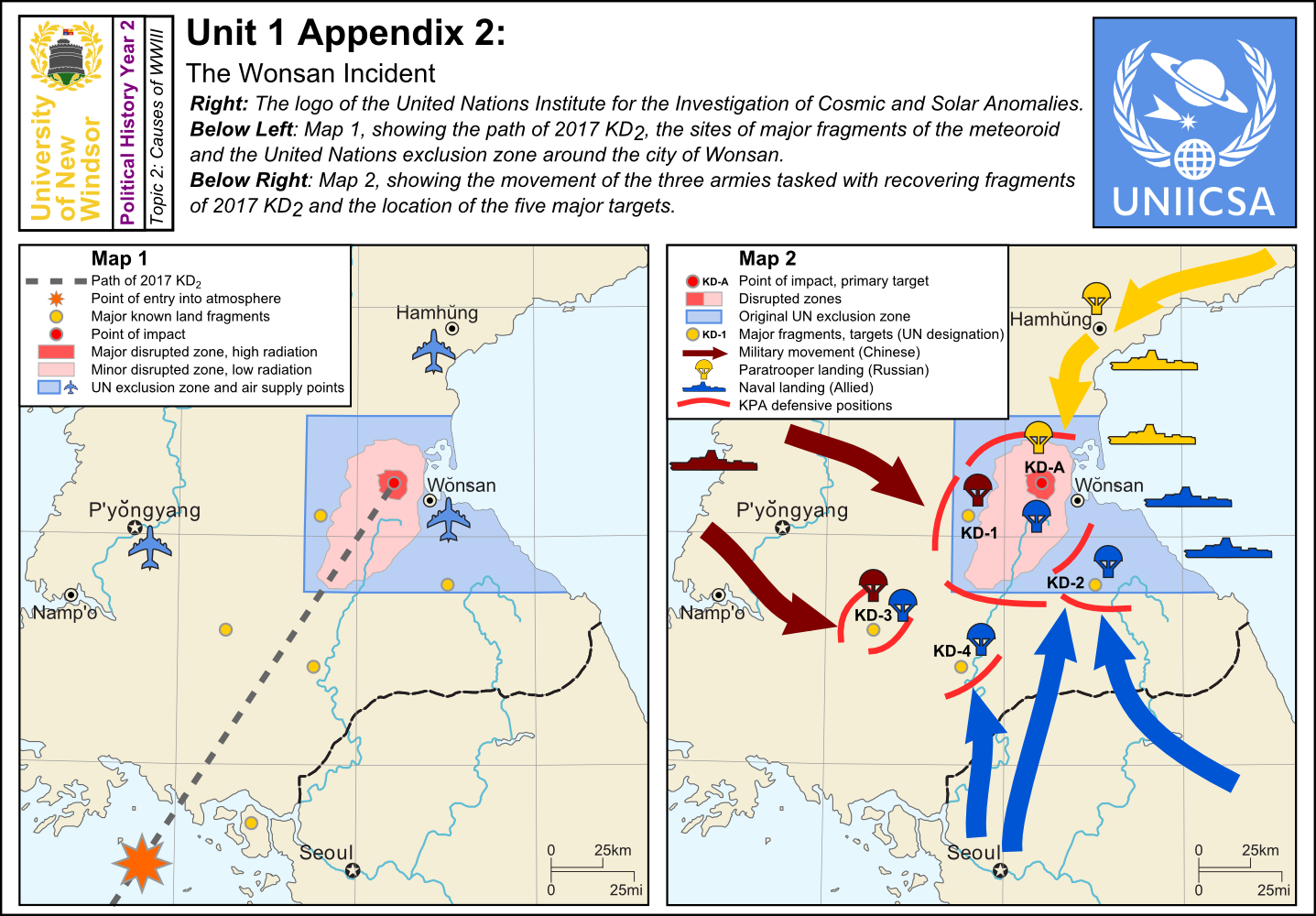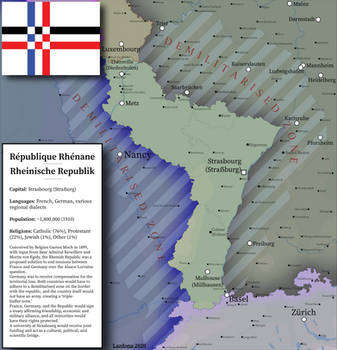ShopDreamUp AI ArtDreamUp
Deviation Actions
Description
This was my first entry into the Map of the Fortnight contest on AH.com. I've been following it for a while and finally got around to entering! It also happens to be the first actual thing I've made since opening this account.
The topic was a map showing a rush for a resource (like a gold rush), I decided to depict a scramble for meteor with new materials but I decided on perhaps the worst place in the world it could impact .
.
This is designed as a section of a political history course.
UofNW: Political History Year 2
Topic 2 Unit 1
The Wonsan Incident
In August 2017 the United Nations Institute for the Investigation of Cosmic and Solar Anomalies (UNIICSA - pronounced you-nee-saa) detected a previously unknown meteoroid, approximately 95 tonnes, heading for Earth. The object was given the designation 2017 KD₂ (often colloquially shortened to Kadi in the press) and was tracked entering the atmosphere above the Yellow Sea just off the Korean coast. The object shed several fragments before finally impacting several kilometres outside the North Korean city of Wonsan.
The initial scientific reaction was muted, despite its size 2017 KD₂ would never be examined due to it falling under the jurisdiction of the secretive North Korean government, who refused to hand over any samples. Fortunately for the scientists however, one large 6 tonne fragment fell onto Ganghwa Island, which was within South Korea. This was reclaimed, ignoring weak diplomatic protests from the North, by the South Korean military and put under guard in Seoul. Samples were taken and examined by universities and technical firms in Seoul.
At the same time the North Korean government reluctantly revealed to the International Atomic Energy Agency that the impact had cracked open a secret nuclear facility located north of Wonsan. The United Nations was forced to declare a roughly 300 km² exclusion zone around the landing site, as shown in Map 1, as well as being assigned three of North Korea's airports (in an attempt to keep them away from military airfields). The exclusion zone was arguably made bigger than required at the requests of Western powers and South Korea who aimed to use it a propaganda centre.
All this changed in October when the scientists examining the Ganghwa Island fragment published their results. Their findings shook the world: the materials within the meteoroid were found to be a 99.7% perfect room-temperature superconductor, the holy grail of materials science.
Unfortunately once the announcement was made that the fragments of 2017 KD₂ were of immense value, North Korea closed its borders and forced the evacuation of UN staff. The North Korean leader leader, Kim Jong-un, announced that North Korea was willing to sell half of the main 48 tonne remnant to the highest bidder, whilst keeping hold of the other fragments and the remaining 24 tonnes for its own use.
These actions provoked outrage around the world, leading to the suspension of North Korea from the United Nations. Technically North Korea had every right to do what they wanted to with material that landed in their territory under the UNIICSA treaty, however the Western Powers made it clear that they would use force if necessary to claim the material for "the good of humanity". As such an international taskforce was created (Codenamed Operation Liberator by the United States, the UK and Commonwealth contingent worked under Operation MAGENTA), formed of (in order of size) American, South Korean, European (French, German, Polish and others) and Commonwealth (British, Canadian, Australian and others) groupings.
Both Russia and China blocked formal UN intervention in the security council (with Brazil and South Africa abstaining), but both began readying task forces for themselves, to intervene in their own national interest. In the winter of 2017 the "Scramble for Kadi” (as it has since been titled) began.
The Northern Korean People's Army offered little resistance crossing into North Korea, the vast majority had been withdrawn to protect the major fragments of the meteoroid. The three main armies, the People's Liberation Army taskforce, the Russian Union Army taskforce and the Allied taskforce all advanced into the centre of North Korea, shown in Map 2. Paratroopers rained down onto the main impact site (designated KD-A) and the four major fragments (KD-1 through 4), whilst the three navies landed men on the coast.
It was at the now infamous site designated KD-3, in the North Hwanghae province, that by chance both Chinese and American special forces independently chose to infiltrate on the same night. The Chinese knew the second column of the PLA force was only days away, whilst the Americans knew they had little backup as the Allied armies were concentrated on KD-4 to the south. What happened at KD-3 is still a closely guarded secret, suggesting both sides were at fault, but whatever happened eventually lead to the outbreak of the largest war the world had ever seen.
See Also:
Unit 1 Appendix 1: Sources and reading list
Unit 1 Appendix 2: Images and Maps
Next Unit: Unit 2: The Sino-American Conflict
The topic was a map showing a rush for a resource (like a gold rush), I decided to depict a scramble for meteor with new materials but I decided on perhaps the worst place in the world it could impact
This is designed as a section of a political history course.
UofNW: Political History Year 2
Topic 2 Unit 1
The Wonsan Incident
In August 2017 the United Nations Institute for the Investigation of Cosmic and Solar Anomalies (UNIICSA - pronounced you-nee-saa) detected a previously unknown meteoroid, approximately 95 tonnes, heading for Earth. The object was given the designation 2017 KD₂ (often colloquially shortened to Kadi in the press) and was tracked entering the atmosphere above the Yellow Sea just off the Korean coast. The object shed several fragments before finally impacting several kilometres outside the North Korean city of Wonsan.
The initial scientific reaction was muted, despite its size 2017 KD₂ would never be examined due to it falling under the jurisdiction of the secretive North Korean government, who refused to hand over any samples. Fortunately for the scientists however, one large 6 tonne fragment fell onto Ganghwa Island, which was within South Korea. This was reclaimed, ignoring weak diplomatic protests from the North, by the South Korean military and put under guard in Seoul. Samples were taken and examined by universities and technical firms in Seoul.
At the same time the North Korean government reluctantly revealed to the International Atomic Energy Agency that the impact had cracked open a secret nuclear facility located north of Wonsan. The United Nations was forced to declare a roughly 300 km² exclusion zone around the landing site, as shown in Map 1, as well as being assigned three of North Korea's airports (in an attempt to keep them away from military airfields). The exclusion zone was arguably made bigger than required at the requests of Western powers and South Korea who aimed to use it a propaganda centre.
All this changed in October when the scientists examining the Ganghwa Island fragment published their results. Their findings shook the world: the materials within the meteoroid were found to be a 99.7% perfect room-temperature superconductor, the holy grail of materials science.
Unfortunately once the announcement was made that the fragments of 2017 KD₂ were of immense value, North Korea closed its borders and forced the evacuation of UN staff. The North Korean leader leader, Kim Jong-un, announced that North Korea was willing to sell half of the main 48 tonne remnant to the highest bidder, whilst keeping hold of the other fragments and the remaining 24 tonnes for its own use.
These actions provoked outrage around the world, leading to the suspension of North Korea from the United Nations. Technically North Korea had every right to do what they wanted to with material that landed in their territory under the UNIICSA treaty, however the Western Powers made it clear that they would use force if necessary to claim the material for "the good of humanity". As such an international taskforce was created (Codenamed Operation Liberator by the United States, the UK and Commonwealth contingent worked under Operation MAGENTA), formed of (in order of size) American, South Korean, European (French, German, Polish and others) and Commonwealth (British, Canadian, Australian and others) groupings.
Both Russia and China blocked formal UN intervention in the security council (with Brazil and South Africa abstaining), but both began readying task forces for themselves, to intervene in their own national interest. In the winter of 2017 the "Scramble for Kadi” (as it has since been titled) began.
The Northern Korean People's Army offered little resistance crossing into North Korea, the vast majority had been withdrawn to protect the major fragments of the meteoroid. The three main armies, the People's Liberation Army taskforce, the Russian Union Army taskforce and the Allied taskforce all advanced into the centre of North Korea, shown in Map 2. Paratroopers rained down onto the main impact site (designated KD-A) and the four major fragments (KD-1 through 4), whilst the three navies landed men on the coast.
It was at the now infamous site designated KD-3, in the North Hwanghae province, that by chance both Chinese and American special forces independently chose to infiltrate on the same night. The Chinese knew the second column of the PLA force was only days away, whilst the Americans knew they had little backup as the Allied armies were concentrated on KD-4 to the south. What happened at KD-3 is still a closely guarded secret, suggesting both sides were at fault, but whatever happened eventually lead to the outbreak of the largest war the world had ever seen.
See Also:
Unit 1 Appendix 1: Sources and reading list
Unit 1 Appendix 2: Images and Maps
Next Unit: Unit 2: The Sino-American Conflict
Image size
1437x1000px 490.35 KB
© 2011 - 2024 Martin23230
Comments7
Join the community to add your comment. Already a deviant? Log In
this. is. genius.


































